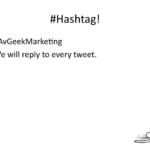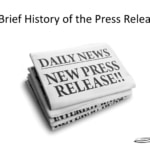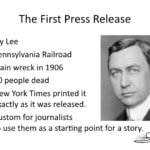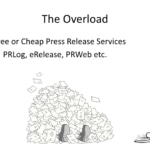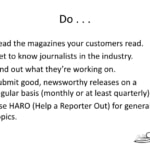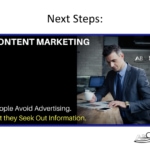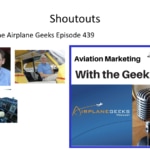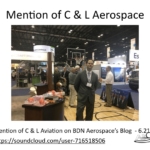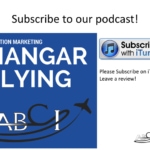Aviation PR -Are Press Releases Still Worth It?
 John and I talk about Press Releases for Aviation.
John and I talk about Press Releases for Aviation.
In the prehistoric days before the internet, press releases were the meat and potatoes of aviation PR.
- But did you know the history of where press release came from?
- And how the black-hat SEO charlatans ruined it for the rest of it?
- And why most editors hated them after about 2000?
- And why you should do them anyway (but do them better than everyone else?)
Find out in this episode! And also
- Shoutout to the Airplane Geeks, for producing my very favorite podcast on the planet, and for being a shining example of where a checklists and digital craftsmanship can take you.
- Shoutout to Yvan Boniface, a master of great Press Release ideas.
- And Insider Pat Lemieux gets unexpected press for a great idea MONTHS after the fact.
Note – you may also enjoy our Webinar – Working with the Press.
Transcript – Aviation PR -Are Press Releases Still Worth It?
[MUSIC]Narrator: You’re listening to aviation marketing hangar flying. The community for the best sales and marketing professionals in the aviation industry. You can’t learn to fly just from a book, you learn from other pilots who know the tools, the skills, and the territory. Your hosts John and Paula Williams are your sales and marketing test pilots.
They take the risks for you, and shares strategies, relevant examples, hacks and how tos. Be sure to subscribe on iTunes so you won’t miss a thing.
Paula Williams: Welcome to aviation marketing Hangar Flying, Episode number 73. Today we’re going to be talking about press releases and aviation pr.
So I’m Paula Williams.
John Williams: And I’m John Williams.
Paula Williams: And we are ABCI. And ABCI’s mission is-
John Williams: To help all you ladies and gentlemen out there in the aviation world sell more products and services
Paula Williams: Absolutely, so, if you have any questions, or comments, or anything else about today’s episode, or about aviation marketing, or about press releases [LAUGH] or about anything else we talk about today.
You can submit comments or questions to us using the hashtag #AvGeekMarketing. Or on our blog or on any of our social media channels. And we will do our best to reply to every tweet. And today, we’re doing something. Adding a couple of things that are kind of long overdue to our podcast.
One is shout-outs to people in the industry who are doing really cool things. And the second one is basically letting you know what our insiders are up to. And our insiders are of course AVCI clients who are always doing really cool stuff. And so we thought we would let the rest of you know what they’re up to and some of those things going on.
So we’ll add that at the end of the episode. But today, first of all, we’re going to talk about press releases, right?
John Williams: Absolutely.
Paula Williams: Okay. So three big ideas, we try to always have three big ideas. First a brief history of press releases and why some people hate them so much.
John Williams: [LAUGH]
Paula Williams: What good are they? And dos and don’ts for press releases.
John Williams: Yeah, really.
Paula Williams: Okay, so let’s start with a brief history of the press release. Do you know the story?
John Williams: I do not.
Paula Williams: You do not. Wow, I get to tell you something you didn’t know.
That is so impressive. Okay, so according to press, public relations lure, the press release was born following a train wreck on October 28, 1906 in Atlantic City, New Jersey, that left more than 50 people dead. The train was owned by the Pennsylvania Railroad. I just about said Transylvania railroad.
Sounds like a creepy story. The Pennsylvania Railroad, one of Ivy Lee’s clients, in response to the disaster, he convinced the railroad to issue a statement about what had just transpired. In doing so, he set in motion a practice for companies to address issues important to them, or in the case of the railroad, to offer an explanation of what had happened.
So The New York Times was said to have been so impressed by Lee’s press release that the newspaper printed it exactly as Lee had written it. Although it’s rare for media outlets to use press releases verbatim these days, they still often act as a starting point for the journalist to create a story.
When Ivy League, Ivy Lee not Ivy League [LAUGH] Ivy Lee created what was widely believed to be the first press release. He established an invaluable component to any public relations campaign. The times and technology may have changed but there are several things a press release can accomplish to make its use as relevant today as when he was alive, right?
So, nowadays, people don’t typically print press releases verbatim, right? Journalists are always looking for stories. They are over worked and underpaid just like the rest of us. And press releases are a really good way to let them know about things that are going on that are of interest to them and that they should be writing about.
So that was really the intention of press releases but then, so that was kind of the good, right?
John Williams: Yes.
Paula Williams: [LAUGH] Then we move on to the bad. What happened after that? Everybody started doing press releases because companies realized, you know what, we can control the news.
And then the Internet happened. [LAUGH]
John Williams: Well, that’s a leap forward.
Paula Williams: [LAUGH] That is a leap forward. And when the Internet happened, companies even more decided, you know what, we can issue a press release any time we darn well please. And we can say pretty much anything, and make it a press release.
They also discovered that a lot of the news outlets would cover these press releases, and would give them links back to their site. So when search engine optimization became a thing, a lot of search engine optimization companies recommended issuing press releases, whether or not there was actually any news going on, right?
John Williams: Yes, they did.
Paula Williams: So these free or cheap press release services like PRLog, eRelease, PRWeb, there’s dozens of them out there, became really popular with people who weren’t spending the time or energy to do the kind of craftsmanship that’s really required for press releases. So, they got really trashy, really badly written about things that weren’t necessarily newsworthy.
And journalists just started ignoring them, right?
John Williams: And nowadays that’s mostly been resolved by higher quality news release services, right?
Paula Williams: No, it’s still going on.
John Williams: Great.
Paula Williams: [LAUGH] So this is the problem. This is what we’re up against. It’s that there are still an avalanche of press releases coming in to just about every major news outlet.
So if you want to stand out, you have to work a heck of a lot harder than you used to. And that’s why it’s more difficult and why it takes a lot more time and energy to cultivate those relationships so that you’re not just one speck in a pile, right?
Okay, okay. So here’s why you should do them anyway. You have an opportunity to get your product or service mentioned in a lot of different places. And we have done a couple of press releases for Aero Expo Panama Pacifico. That is an expo that’s coming up in Panama in April this year.
And one of the ways that Yvan Boniface, he’s our client for this event, wanted to promote his event was to do press releases. And it was a really good call on his part and we agreed with him because we’ve gotten coverage in a lot of places. So AIN Online has run his news stories, Aviation Week, Aviation Pros.
A lot of, DOM Magazine, of course, a lot of Latin American publications because they translated the release into Spanish. So Panama means business, [FOREIGN]. My pronunciation is probably fifth-grade Spanish. [LAUGH] America Economia and Hangar X, those are all Latin American publications. But we’ve also gotten mentioned on a lot of the major news outlets NPR Marketplace and a lot of the others.
So how-
John Williams: Did we do that?
Paula Williams: [LAUGH] Exactly how do you write good press release that’s actually got noticed as opposed to bad press releases that end up in the pile somewhere, right?
John Williams: In the digital trash basket.
Paula Williams: In around file, right. Okay so we’ll talk about some dos and don’ts.
We’re going to do the don’ts first. This is what you don’t want to do. You don’t want to rely exclusively on free or cheap press release services, because everybody else does, and everybody knows they’re cheap or free.
John Williams: And they don’t necessarily, and they don’t get the coverage.
Paula Williams: Right, and they don’t do any vetting to see if what you’re submitting is news worthy, or anything else.
So you get submitted together with all the rest of the day’s trash to all of the news outlets and so a lot of them get ignored. You do not ever want to submit press releases that are not newsworthy or that are badly written. It makes you look bad.
It makes the reporters, even if there is a newsworthy story, if it’s badly written, they have to work harder. And everybody these days is overpaid and underwork, especially-
John Williams: And they don’t want to. If they see another one from me, they don’t want to use it.
Paula Williams: Right, so you get a reputation for, don’t print that stuff.
It’s way too hard to clean it up. If we only have five minutes, pick somebody that writes cleaner releases to get this in under the deadline, right?
John Williams: Exactly.
Paula Williams: Okay. You don’t ever want to submit more than one per month, per company and of course, there may be an exception to this.
If you happen to have two news worthy events unexpectedly, then by all means break the rule.
John Williams: Of course.
Paula Williams: But-
John Williams: It has to be very newsworthy though in the second one.
Paula Williams: Exactly. If they get used to seeing way too many from you or way too high of a volume, they start to suspect that you’re not necessarily as newsworthy as maybe you should be.
I’m going to add another one to this that I didn’t have written down. And that is, don’t drive reporters crazy by calling them multiple times after a release and asking them, when is my release going to run? The reporters don’t work for you, they work for their publication. So certainly don’t drive them crazy.
And don’t get upset with them if they don’t run your release, right?
John Williams: Exactly.
Paula Williams: Okay, cool so let’s talk about some dos.
Paula Williams: You do want to read the magazines that your customers read. So whether or not you’re interested in The Robb Report or Golf Digest [LAUGH] or whatever maybe your charter clients happen to be interested in those magazines.
Read them. You may find out some things that are really interesting about some of the terminology they use. About some of the factors in the market that are effecting them that you may not know about. You also get a feel for what those magazines consider newsworthy. And you may get some ideas about how to frame a story.
John Williams: You want the words you put out there to mesh with what’s already in the magazine.
Paula Williams: Exactly. So the tone, the vocabulary, the topics, the tempo, a lot of different things. If a magazine is very, very factual and news specific, then you really want to write that way.
If a magazine is very descriptive, like a style magazine or a lifestyle magazine, then you want to write in that tone to make it easier for those reporters to take bits and pieces of your press release and slide them right in, right?
John Williams: Sort of like, if I can use a metaphor here.
Paula Williams: Hm, please do.
John Williams: If the magazine is about hip hop dancing, you sure don’t want to put Foxtrot in there.
Paula Williams: [LAUGH] Exactly.
John Williams: [LAUGH].
Paula Williams: Right, so you want to make it kind of a stylistic match as much as you can. You do want to get to know the journalists in your industries.
So next time you are at one of those mixers at a convention, and you happen to run into a reporter, make sure you remember their name. [LAUGH] Get to know them. They’re really good people to know because, well, for actually lots of reasons. Most of them are really interesting people who have a lot of great stories.
But also, they may be able to help you when it’s time to publish your release if you know them and they know you, and they know what you do then you’re familiar to them. And people like to work with people that they are familiar with, right?
John Williams: Yes.
Paula Williams: Okay.
John Williams: Really get to know them personally as you work your way through the industry, too.
Paula Williams: Absolutely, find out what they’re working on. And you can do that by reading the magazine on a regular basis, you know what kind of stories they’re into. You know maybe from their editorial calendar what’s coming up next on their list of things to do.
John Williams: Or you now from our editorial calendar.
Paula Williams: Or you know from our editorial calendar what they’re up too, and how you might be able to help them get their work done. So, everybody loves a helping hand and if you can do it in a way that puts your company in a good light, that’s a wonderful thing.
John Williams: Which goes, by the way, we need to mention that our editorial calendar is composed annually and for our clients only.
Paula Williams: Exactly. And then the last one is, you want to, well the second to the last one, sorry. You need to submit good news worthy releases on a regular basis, okay?
So you need to make sure that they don’t forget about you, at by writing something. And there’s always a good story. If you’re an active company that’s actually doing stuff in the industry, hiring people. Getting new facilities, maybe inventing new processes, other kind of things. There should be something going on at least monthly or quarterly that you can write about.
And if it goes more than quarterly, theyre going to think you’re dead. [LAUGH] Or out of business or something.
John Williams: Once you start this, this needs to be one of those things you keep up like trade shows. You go to one, you need to go to the next one next year Exactly.
Paula Williams: And you can use, one service that I think is really helpful is HARO or Help a Reporter Out. This is a once a day email. I know you need one more email I like you need a kick in the head, right? [LAUGH] But this one is actually kinda cool because what it is, is it’s a digest of and you can pick the topics that you want.
Unfortunately, it’s not terribly specific to aviation. It doesn’t have very good topics for us. But sometimes you can find niches and other kinds of things that are close to what you do. And then you get an email once a day from what reporters are looking for. I’m looking for an interview with somebody who has done this, or I’m looking for charts and graphs or photographs about this topic or that topic.
And if you see one that applies to your company then it’s a great time to contact that reporter. And jump in and help them out, right?
John Williams: Of course.
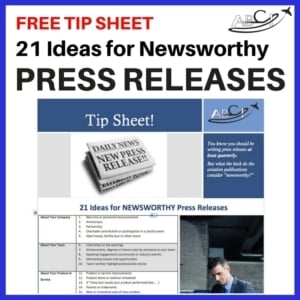 Paula Williams: Okay, cool. We do have a download associated with this episode. It is a tip sheet, 21 topic ideas for newsworthy press releases.
Paula Williams: Okay, cool. We do have a download associated with this episode. It is a tip sheet, 21 topic ideas for newsworthy press releases.
John Williams: These are fairly generic, though, right?
Paula Williams: Well, they’re specific to-
John Williams: To aviation, but generic otherwise.
Paula Williams: Exactly, so basically what you can do with this list is if you want to make sure that you’re submitting at least one press release per quarter, you can go through this list.
And you can probably find something on there that you can write about that is newsworthy, that’s related to your company you can say that.
John Williams: Yeah the idea is just to tickle your brand a little bit so that she’s that means I can write, whatever.
Paula Williams: Exactly. Some of them may not be things that you may think of but that actually do make really good stories.
John Williams: Help you overcome writer’s block.
Paula Williams: [LAUGH] Yeah, help you get past the blank sheet, my gosh I have to write the press release now what do I do syndrome, right?
John Williams: Exactly.
Paula Williams: Okay, cool.. So next steps if you want to take it a step further than, of course our content marketing subscription is a product where we do the writing for you.
And we write one article or press release per month and we try to use the heck out of it. So we may use the same story as a blog article, a press release, something shorter for your newsletter. You can break it apart into a million little pieces for your social media.
Maybe not a million, but maybe ten [LAUGH] little pieces-
John Williams: Better to get you everywhere that it’s possible to use it.
Paula Williams: Exactly and if your focus is on press releases, we will definitely come up with at least one good idea for a press release once a month about your company.
So, you know, that’s something that we do for our clients. And if you’d like to have that done for you, just hop on over to our website. Click on services and then click on content marketing and you’ll see the details of what’s included in that package. And how much it costs and all the details.
And we’ve got two levels of service for that one that is slightly less expensive and one that’s slightly more. And you can see what’s included in either package, right?
John Williams: Absolutely.
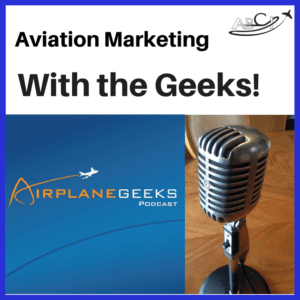 Paula Williams: Okay. So shoutouts this month, the Airplane Geeks. This is actually one of the ways that we got kind of introduced around in the aviation industry when we were new in the field about ten years ago.
Paula Williams: Okay. So shoutouts this month, the Airplane Geeks. This is actually one of the ways that we got kind of introduced around in the aviation industry when we were new in the field about ten years ago.
The guys that run the Airplane Geeks, they do fantastic craftsmanship of their podcast. And they’re on their 400 and something episode. I’m going to refer you to episode 439 because I was a guest on that podcast and we talked about marketing, which is a lot of fun with Max Flight or Max East.
[LAUGH] And Max Trescott, who is Max West. Max East is, of course, in Boston. Max Trescott is in California. So, that is why they call them Max East and Max West. And Rob Mark. Our old friend Rob. He’s been on our podcast once. We’re going to have to make sure we get the Max’s, one or the other of the Max’s on one of our future episodes.John Williams: And if you’re looking at this visually, the microphone you see there is the one she’s talking on right now.
Paula Williams: Absolutely, yeah. This is a Frank Sinatra microphone. This is really cool. That’s a neat story. John found it, actually I told John I wanted a podcasting microphone and I wanted to spend 60 something dollars.
He said no, no, no, no, no, no [LAUGH].
John Williams: Yeah, I had this microphone out in the garage. I went out and found it, rebuilt it to spec and then gave it to her to use and plugged it in. Because this particular microphone was given to me, I believe, in 1958 or 59 and it was about 10 years old when I got it.
I don’t even know why I kept it. Matter of fact, you can’t even get the connections for it anymore. We had to rebuild the cable using the connections we got. So, but it has extremely, as you can tell, good quality.
Paula Williams: Right, yeah, I love this microphone. It’s fantastic.
But one thing that you’ll notice when you listen to The Airplane Geeks is the craftsmanship on their podcast is absolutely superb. I learned a lot just from doing the podcast with them. And going through the checklist with them on their sound. And doing the other things that they do.
And they do a lot of really fantastic little details of digital craftsmanship after the fact. They’ve got a list of their guests by episode on their website. They’ve got, their show notes are just impeccable. They do a really good job on their podcast. So we learned a few things and are doing a few things differently because of our experience there.
And they took a few minutes after the podcast and talked shop with John about audio and other kinds of things. So it was really fun. It was a really good experience. And I just wanted to thank those guys for a really great conversation and a really great experience.
John Williams: Absolutely.
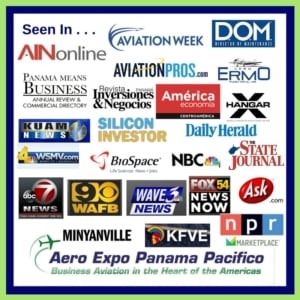 Paula Williams: Right, cool. So what’s up with the Insiders? Wanted to mention, of course, Yvan Boniface, since we mentioned him in this episode. We’ll keep mentioning him [LAUGH] He is acquiring exhibitors up one side and down the other. It is absolutely astonishing the speed at which he is selling spaces in the Aero Expo Panama Pacifico.
Paula Williams: Right, cool. So what’s up with the Insiders? Wanted to mention, of course, Yvan Boniface, since we mentioned him in this episode. We’ll keep mentioning him [LAUGH] He is acquiring exhibitors up one side and down the other. It is absolutely astonishing the speed at which he is selling spaces in the Aero Expo Panama Pacifico.
And just an absolute superb sales person. And that’s going to be happening April 20th and 21st in Latin America, of course, in Panama City. So if you are at all interested in marketing any aviation products or services to the Latin American market, this is a really good opportunity for you to maybe dip your toe in.
And meet some people and have a really great host who can help you out, because Yvan does a really great job of putting together the event. This is the second annual event. And a lot of the folks who were there last year are just excited to come again, and exhibit there.
And it’s just a really good opportunity to get into a really fast-growing market.
John Williams: He’s kind of personal business-oriented guy that’s got a sense of humor.
Paula Williams: Exactly. You know a lot of fun to work with. And we’re really enjoy him. So that’s fantastic. Another shout-out to Pat, Pat Lemieux from C & L Aerospace.
We don’t usually mention our competitor’s media, but BDN Aerospace, on their blog, they have a little audio post on SoundCloud. And they’re talking about trade shows and that there’s 6 minutes 21 second mark they talk about what Pat did at the NBA A show last November. So when you do a really great job of doing something remarkable and memorable, it’s kind of the gift that keeps on giving, right?
John Williams: Yeah that thing they did at NBA didn’t we help them with some ideas on that?
Paula Williams: It was Pat’s idea, so, but we did talk with them about it a few times before and he did such a fantastic job of doing the heck out of it. They did a basketball stand, you know a basketball themed event with a parquet floor.
And just the details and the execution of this were really done well.
John Williams: Complete with cheerleaders.
Paula Williams: Complete, exactly.
John Williams: [LAUGH]
Paula Williams: So, kudos to Pat and that was what, November, December, January, February, four months ago and it’s still being talked about so what does that tell you?
John Williams: That was a good idea.
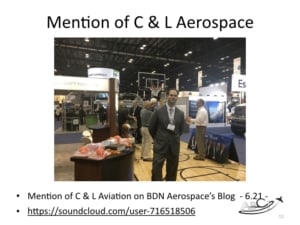 Paula Williams: That was a really good idea. So yeah go ahead and listen to the BDN Aerospace mention on their little audio file and see what you think. So go sell more stuff.
Paula Williams: That was a really good idea. So yeah go ahead and listen to the BDN Aerospace mention on their little audio file and see what you think. So go sell more stuff.
John Williams: America needs the business.
Paula Williams: Absolutely and subscribe to our podcast,
John Williams: And that was by Sue Ziglar, by the way.
Paula Williams: Yes it was, yep. Subscribe to our podcast aviation marketing Hanger Flying on iTunes. Stitcher or a Google play or anywhere else that fine podcasts are found. And do please subscribe and do also please leave a review. And let us know what you think of this podcast.
And those reviews really do mean a lot to us. So we really appreciate those of you that have left reviews and those of you who haven’t but will soon.
John Williams: Thank you in advance for those are good reviews [LAUGH].
Paula Williams: Absolutely. Have a great afternoon and thank you for joining us.
John Williams: Ciao.[NOISE]
Narrator: Thanks for joining us for aviation marketing Hangar Flying. The best place to learn what really works in sales and marketing in the aviation industry. Remember to subscribe on iTunes and leave a rating.
You might also enjoy our Webinar on Aviation PR
How to Write Press Releases that get noticed, and prepare ideal Public Relations (PR!) messaging for an Aviation Company
- “Why do my competitors always get mentioned in aviation publications and magazines, and WE never do? Our product is much better!”
- “Do you HAVE to spend a fortune on advertising to get mentioned in the industry press?”
- “How do we handle the press if we have a negative incident on the field or that’s associated with us in some way? How do we keep from being a cautionary tale? Should we talk to the press or avoid them? Is ‘no comment’ better than providing information?
..
Podcast: Play in new window | Download
Subscribe: Spotify | Amazon Music | RSS



